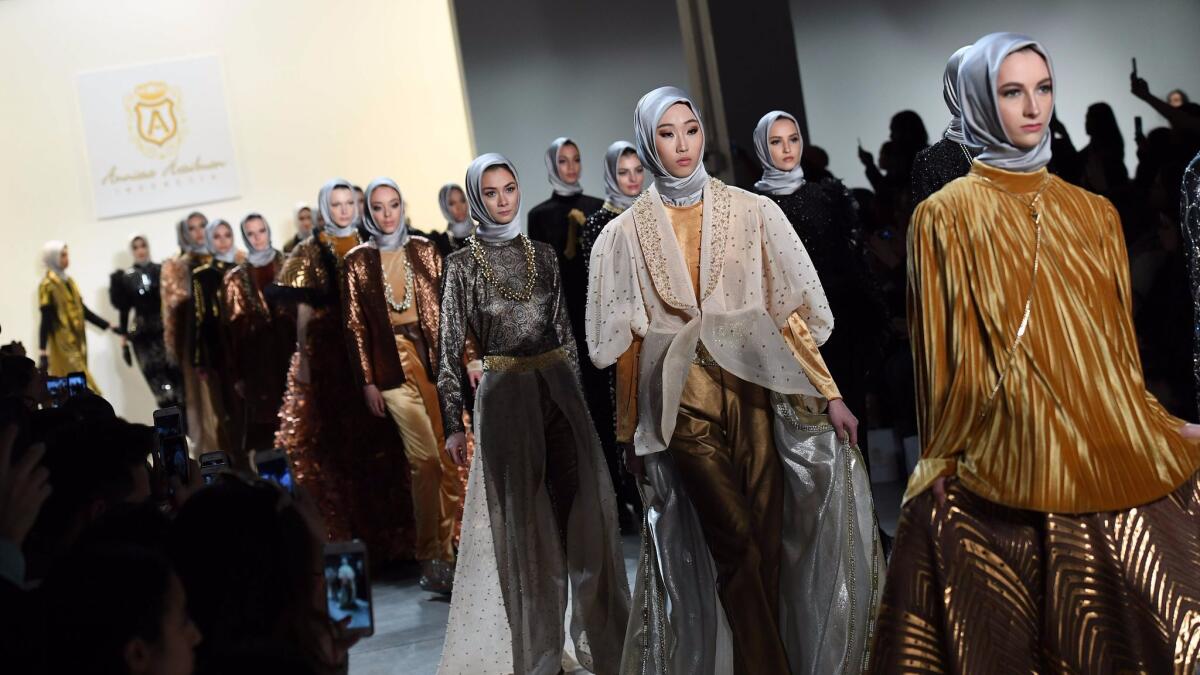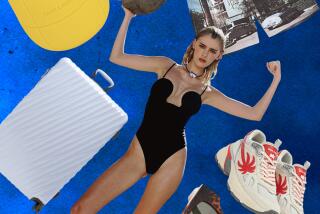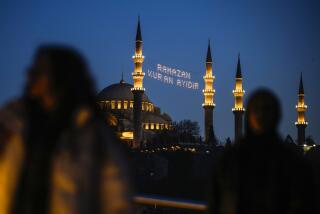Op-Ed: Islamic style is showing up on catwalks, in mainstream stores and on non-Muslim women

For a decade I’ve studied how Muslim women dress. Ripped jeans tucked into combat boots, structured jackets accessorized with designer sunglasses, flowy pastel chiffons embellished with crystal-encrusted brooches and tailored batik dresses paired with hand-dyed head coverings. These are just a few examples of what I call pious fashion: clothing that aims to be modest and modern.
For most of the years of my research, the fashion world barely noticed Muslim style and the style makers I studied. But now I see pious fashion showing up on catwalks, in department stores and on non-Muslim women. It’s almost as if modesty has gone mainstream.
The majority of Muslim women around the world don’t wear traditional black full-body covering like chadors, abayas or burqas, and there’s a lot of diversity in what they do choose. What counts as attractive differs wildly in the varying cultural contexts in which Islam is practiced, and Muslims have competing opinions about what defines modern modesty. For some, it’s about covering parts of the body — hair, shoulders, arms, chests and legs — although sometimes a scarf is just loosely draped, sleeves are three-quarter, pants are cropped and knees peekaboo out of those ripped jeans. For others, modesty means disguising feminine curves via volume and proportion.
That the fashion industry has begun to take modesty into account is at least in part an economic phenomenon. Muslims spend about $230 billion a year on modest clothing, and estimates predict that figure will reach $327 billion by 2019. That’s real money, even within the context of a global apparel market valued at $3 trillion.
Modesty is spreading because of the tremendous style success of young Muslim women.
High-end design houses are clearly trying to tap into the luxury end of the market. Last year Dolce & Gabbana released a collection of headscarves and coordinated abayas made of their signature fabrics. A $2,000 abaya at Harrods in London is one sort of benchmark for Muslim fashion, but even in Dolce & Gabbana’s hands, that’s a fairly traditional garment — it wasn’t exactly fashion forward.
Style innovations have come from lesser-known designers. Consider Jakarta-based Anniesa Hasibuan. Last year, she became the first designer to show an Islamic collection at one of New York Fashion Week’s official venues. Necklines were high, sleeves were long, and the skirts swept the floor. Every model went down the runway wearing a headscarf. Hasibuan received a standing ovation from the who’s who of fashion.
What goes down a runway gets picked up by the affordable mix-and-match brands. For Muslim style, Uniqlo comes to mind. The company hired Japanese British designer Hana Tajima a couple of years ago. Her first collection was marketed as “modest” and was available only in Southeast Asia. Now you can buy her designs at Uniqlo flagships all over the world, including on 5th Avenue in New York City. The PR for her Fall/Winter 2017 collection no longer mentions that she’s Muslim, and the ads use phrasing like “a new silhouette for modern culturally-aware women.”
Items from Uniqlo’s standard collections also lend themselves to pious fashion adaptation. A Uniqlo sleeveless jumpsuit I just purchased was layered over a long sleeved shirt on the in-store mannequin: perfectly fashionable, perfectly modest. And nothing about it reads immediately as “Muslim.”
Cosmetic companies are getting in on the action as well. Last November, CoverGirl made American beauty vlogger Nura Afia its first headscarf-wearing Muslim spokesperson. Afia joined a lineup of the brand’s most diverse models to date in a high-profile campaign promoting a new brand of mascara. This was more than reaching out to a niche market. CoverGirl think it can sell more mascara to us all with an inclusive vision of beauty.
Here’s perhaps the strongest evidence that Muslim aesthetics are making inroads in mass culture: Season 16 of the TV design competition “Project Runway” features Ayana Ife. She’s Muslim. She wears a headscarf. Her designs cover a lot of skin. But her clothes are “not just for Muslim women” she tells the producers. They are for all women “who love modest fashion.”
And among the show’s other contestants, there also have been modest designs. In Week 1, Kudzanai Karidza made a swoon-worthy red and blush tunic and long pants that would transform into modest fashion with the addition of a tight long-sleeved top. In Week 3, one version of Amy Bond’s convertible jumpsuit was undeniably modest. The silhouette of Samantha Rei’s silk sleepwear in Week 4 was translatable to daytime pious fashion. The way Brandon Kee has worked with volume almost always results in pieces that could be incorporated into a modest head-to-toe look.
We expect something new each fashion season, so hemlines and necklines rise and fall, silhouettes come in and out of vogue. It’s possible that Muslim-appropriate garments on the racks may be a side product of this churn. But I can’t help thinking that modesty is spreading because of the tremendous style success of young Muslim women, like the ones who have taught me so much about pious fashion. They look covered and cool. Pious and modern. Their sartorial savvy is at least one reason why women are being told midi skirts and turtlenecks are wardrobe essentials for the fall.
Elizabeth Bucar is an associate professor of religious studies at Northeastern University in Boston. She is the author of, among other books, the just-published “Pious Fashion: How Muslim Women Dress.”
Follow the Opinion section on Twitter @latimesopinionand Facebook
More to Read
A cure for the common opinion
Get thought-provoking perspectives with our weekly newsletter.
You may occasionally receive promotional content from the Los Angeles Times.






